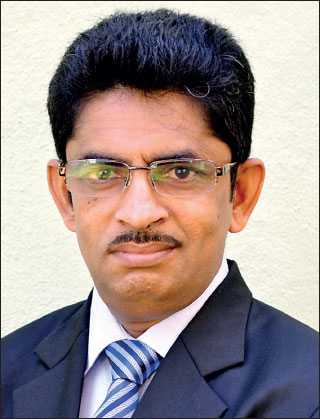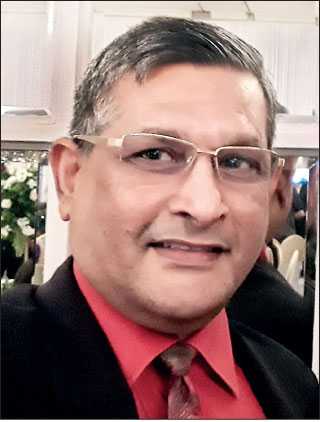Wednesday Jan 07, 2026
Wednesday Jan 07, 2026
Thursday, 2 July 2020 00:36 - - {{hitsCtrl.values.hits}}
As the local economy is beginning to revive after the impact of COVID-19, many sectors have received relief and incentive from the government as support to restart operations and provide facilities to the general public. In this interview, the President and Vice President of Lanka Microfinance Practitioners’ Association (LMFPA), Anura Atapattu and Priyantha Dematagoda, raise concerns about providing sustainable service to the majority of micro and small enterprises sector including small scale farmers, while highlighting the role that LMFPA plays in uplifting the economy through the microfinance industry. Following are excerpts:
Q: What kind of role does the microfinance industry play within Sri Lanka and in the national economy?
Microfinance contributes to poverty alleviation, economic development, reduces vulnerability of low income people for various economic shocks by supporting agriculture and micro enterprises. Essentially, microfinance is to help the poor to come out of poverty as they can engage in an economic activity or build their assets, or invest in children’s education through these loans.
 |
| LMFPA President Anura Athapattu |
 |
| LMFPA Vice President Priyantha Dematagoda
|
Q: How has the microfinance industry been affected with the latest pandemic?
The effect of COVID-19 on the industry can be looked at in different angles. A large sector of the microfinance clientele is self-employed, and they were the severely affected. The economic standstill meant that is had a significant negative impact with no opportunity for them to continue their enterprises. Even farmers, who were granted permission to continue farming, faced issues in procuring seeds and fertilisers. As a result, they have been utilising their frugal funds, leaving them with no capital to restart their livelihoods, even after the lifting of lockdown. This reduced savings capacity of clients will have a prolonged effect as they are unable to repay their loans, and also resulting in MFIs being unable to grant new loans.
The MFIs on the other hand, have not had a single recovery of debts or interest collected in the lock down period and thereafter, which is the source of the institutes. The companies have no reserve of liquidity for basic operational expenses, and has thus affected the payment of salaries of the 22,000 and more employees in the microfinance industry.
In the long term, Lending poses an issue as well. With no cash in-flow, the demand for loans has increased, but it cannot be met since the MFIs themselves are facing severe cash flow deficiencies. The moratorium will establish new patterns of repayment, and some home industries that will take longer to recover will not be in a position to continue repayment as usual.
The pandemic has created new opportunities also. Production of day to day consumables have higher feasibility, but we also see a diversification of businesses who have grasped at the opportunity, like small apparel businesses sewing face masks to meet the timely demand.
Q: What is the Lanka Microfinance Practitioners Association?
The LMFPA is a representative body of the microfinance industry in Sri Lanka. This is a membership association, where the members are stakeholders of the industry; microfinance institutes, technical service providers, and wholesale lenders. We have 57 exclusive MFI institutes in total as members. We represent over 75% of the industry, so apart from state programmes like Samurdhi, commercial banks, non-bank finance institutions and some cooperatives, who also provide micro financing facilities, most others are members of the association.
Q: What incentives have been provided by MFIs and the LMFPA for those affected with the recent pandemic?
The members of the association took a collective decision to grant moratoriums for three months and above to clients, together with interest rebates. In addition, individual institutions have supported the local communities by providing livelihood assistance, dry rations, face masks and support for disinfection processes. The LMFPA has also donated face masks to the Sri Lanka Grama Niladari Association and the Coroners Association. In addition, the association has specified health guidelines to all member MFIs on how to operate in the field.
Q: What kind of support does the LMFPA, and the microfinance industry as a whole, expect from the government?
According to the instructions of the government, banks have provided a six months moratorium to selected borrowers who have been affected, which was also extended to MFIs by the banks. However, MFIs are not included in the entitlement list for the ‘Saubhgya’ working capital loan by the authorities. As a result, there is a shortage of funding lines for MFIs, affecting their working capital. The main MFI clientele is the most vulnerable at the moment, and they have exhausted all their available funds on consumables during lock-down.
For them to recommence their micro business activities now they seek the help of MFIs. Unfortunately, with our own limitations in funding from banks, we are unable to lend the support to our clients to kick start the operations. Therefore we seek the assistance of the authorities to provide funding facilities to MFIs, in order to fulfil the immediate funding requirements of the MFI clients. If this is provided at a reasonable interest rate, the MFIs can in-turn provide the benefits to our customers, which will be an immense relief to the self-employed Micro, and SME sectors.
The LMFPA, as the representative association has already initiated discussions with the Presidential Taskforce to get facilities from the Government. At the first meeting major banks, the Ministry of Finance, the Central Bank of Sri Lanka were present. As the country is on the road of recovery, it is paramount that the low income sectors of the community get all the support they need. The role of MFIs become more significant in achieving this.
Q: What are the advantages a customer gets from engaging with a microfinance plan as opposed to a loan from a bank or unofficial lenders?
Most people who benefit from microfinance would technically not even qualify to apply for a loan in a bank. Microfinance is therefore more accessible to small scale entrepreneurs, industries and traders. The MFIs provide door to door service hence have a high operational cost and take no collateral, making it a high risk transaction. This makes interest rates comparatively high. However, they are low in comparison to the traditional moneylender of a village.
We even visit places in remote rural areas where usually people would need around half or a full day off if they had to go to a bank, but we make the funding process much easier and accessible. Also, MFIs provide support services such as financial advice, training, marketing support, and social support at events like family funerals, hospitalisation, educational scholarships, etc. Usually, we conduct at least three awareness meetings with a client before we disburse a loan, so that they understand the organisation, the benefits of microfinance and repayment pattern/capacity.
The loans are also unsecured and given on a trust basis, meaning that they are collateral-free. At the same time, the loan is written off in case the borrower dies, or becomes fully economically disabled. Some MFIs write off loans at the death of the spouse or breadwinner too.
Q: There have been several negative news circulating in relation to microfinance debts that severely affect people. What is the true picture of this issue?
Initially, micro financing was progressing well in Sri Lanka. Those recipients using the micro loans were benefitting and were progressing well. But this scenario changed due to the long drought that prevailed in major agricultural areas during the last two years, and the over-indebtedness of credit recipients.
Traditionally micro finance was handled by non-profit organisations with a view of helping the marginalised micro entrepreneurs. Most MFIs are not driven by profit but provided services to improve the social standards of the clients. But since of late certain profit-oriented parties have seen microfinance as a cash cow, and exploited the industry to make quick profits. They entrusted marketing teams with loan targets, and through them they aggressively exploited the existing industry.
Usually, microfinance is not for consumption and only given for micro entrepreneurs engaged in some form of livelihood development activity or other form of useful investment such as housing. But, these profit oriented companies, gave loans for consumption, offering loans, beyond their repayment capacity, forcing them towards loan sharks. This aggravated the situation, resulting in few incidents that painted a negative picture of micro finance. The numbers that are quoted are not even accurate, and most of the suicides are linked to personal and family feuds and if any of them are borrowers of micro finance loans that was highlighted as the cause to cover up the main issue to gain sympathy.
Essentially, these issues were blown out of proportion; there are 2.6 million micro finance loan holders, and they highlighted only around 170 negative stories, and when the details were requested to verify they are not provided for investigation by some parties with vested interests.
Overall, the main objective of microfinance has lost its way due to this encroachment by profit motivated institutions and has resulted in some issues in society. A lack of proper regulation system has been the major factor for this situation resulting in the intrusion of merely profit driven lenders with high interest rate loans given without assessing the purpose of loans and repayment capacity of the clients, which are essential integral elements of the true microfinance concept around the world.
Q: What are the corrective measures that the Microfinance Association can take to eliminate these issues?
As a comeback, the Association has introduced a ‘Code of Conduct’ for its members, to ensure that MFIs do not take advantage of clients and to conduct proper pre disbursement scrutiny in terms of the purpose and the repayment capacity, then post disbursement verification of end use of funds and acceptable collection methods are followed by member organisation thus avoiding undue harassments of clients and more importantly maximum applicable interest rate on loans.
However, in consultation with the authorities more progressive regulatory framework to establish a Microfinance Regulatory Authority was discussed and proposed with the stakeholders to include all Microfinance and Microcredit under this authority.
Microfinance is actually a service for the poor and this is one way that the government can bring in the private sector or the non-government sector to help the development of the economy and help improve the livelihood of the low income segment. If the funding costs for MFIs can be reduced, the lending rates for poor people can also be reduced. The government should get involved to make these funds available to the MFIs at a reasonable interest rate. Some institutes make a loss simply because MFIs have to pay the tax component which is the same rate as a bank.